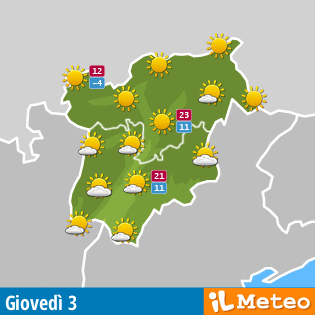Brenta Dolomites
The Dolomites of Trentino
 |
| Italian |

The Brenta Dolomites are on an area of 11.135 hectares, is the fourth of the nine UNESCO sites for extension. They are totally in the province of Trento and are part of the Adamello Brenta Natural Park. This is the only group of the Dolomites to the west of the Adige River. The group is approximately 42 kilometres long and 15 kilometres wide, and this seems to represent a kind of backbone of pure rock. The Brenta Dolomites are delimited by the Val di Sole at north, by the Outer Giudicarie at south, instead by the Val di Non at east, along with Molveno Lake and Sella di Andalo, then by the valley and the basin Rendena di Campiglio at west. From the perspective of the Geology of the Dolomites, this group documented the structural and stratigraphic evolution of the southern margin of the Italian Alps, and more it makes evidence of the tectonic history of the Dolomites. At the foot of this great mountain range are the famous tourist resort of Andalo and Madonna di Campiglio.
The different areas of Brenta Dolomites
This group of Dolomites can be divided into four main groups. The most northern stretches from Passo Grostè up to the Val di Sole, through the Catena del Sasso Alto, Massif of Sasso Rosso and Massif of Pietra Grande. The central group consists of the Massif of Cima Grostè of 2.901 meters of altitude, the catena of Sfulmini and the massif of Peack Brenta, 3.150 meters high. The Group of Campa is geared towards the Val di Non and is formed from the chains of Fibbion and Monte Corona and even groups of Gaiarda and Altissimo. The group includes the southernmost chain Ambiez, the Nodo del Ghez, the Vallon and the Costiera del Sabbion, then the Massif Tosa, whose top, 3.173 meters, is the highest of the whole group of Brenta. Besides those already mentioned, there are other major peaks, i.e.: Torre di Brenta of 3.014 meters, the Crozzon di Brenta to 3.135 meters high, the aforementioned Vallon with its 2.935 meters, Cima d’Ambiez, 3.096 meters, Campanile Alto, which reaches 2.937 meters and the Campanile Basso 2.883 meters.
The Brenta Dolomites are assort of island of Dolomite surrounded by large groups of Presanella and Adamello. The group shows the characteristics of Dolomite, successive peaks marked by ramparts, steeples and bell towers. At the foot of the walls down gullies that merge later with the grass and vegetation. There are no real access roads but paths that unfold within the group itself. In this area, sometimes so wild, the last surviving community of brown bears originating in the Alps. A feature of the these group of mountains are the lakes, there are numerous in this area. The largest is Molveno Lake, which was formed after a massive landslide, about 4000 years ago. It extends for more than three square kilometers and is the second of all the Trentino. Even if smaller, Lake Tovel is important from the naturalistic point of view. In the past, during the summer, an algae coloured it in red. The phenomenon was terminated in 1964 for reasons not certain. Some think the lack of organic matter produced from cattle that once grazed in the area.
The mountaineering history of the Brenta Dolomites is also interesting. It was one of the groups that was explored later among Dolomites. But then the interest in these peaks grew to the charm of places and landscapes and for the boldness of his climbing. Here the great Irish climber Jhon Ball was the first to reach the Bocca di Brenta, in 1864 too.
